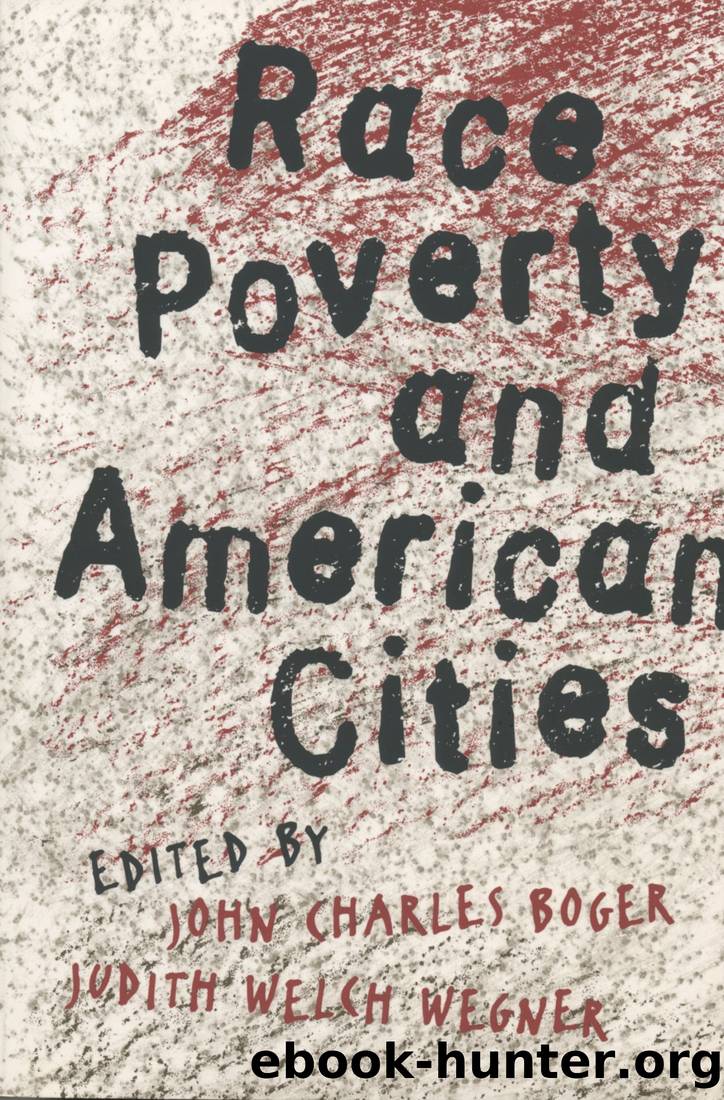Race, Poverty, and American Cities by John Charles Boger & Judith Welch Wegner

Author:John Charles Boger & Judith Welch Wegner [Boger, John Charles & Wegner, Judith Welch]
Language: eng
Format: epub
Tags: Political Science, Public Policy, General
ISBN: 9780807899915
Google: gCp4DgAAQBAJ
Goodreads: 21985577
Publisher: Univ of North Carolina Press
Published: 1996-09-09T13:08:21+00:00
Notes
1. Report of The National Advisory Commission on Civil Disorders (New York: Bantam Books 1968), 407 (hereafter cited as Kerner Report).
2. See John Charles Boger, âRace and the American City: The Kerner Commission Report in Retrospectâ (in this volume).
3. Kerner Report, 475.
4. Ibid., 472â73.
5. Ibid., 482.
6. Ibid., 406.
7. John D. Kasarda, âUrban Industrial Transition and the Underclass,â Annals of the American Academy of Political and Social Science 501 (1989): 26â47; John D. Kasarda, âUrban Employment Change and Minority Skills Mismatch,â in Creating fobs, Creating Workers: Economic Development and Employment in Metropolitan Chicago, ed. Lawrence B. Joseph (Champaign: University of Illinois Press, 1990), 65,82.
8. William Julius Wilson, The Truly Disadvantaged: The Inner City, the Underclass, and Public Policy (Chicago: University of Chicago Press, 1987), 135.
9. NCI Research, Identifying Employment Opportunities for Inner City Residents (1991), 5.
10. Ibid.
11. David T. Ellwood, âThe Spatial Mismatch Hypothesis: Are There Teen-age Jobs Missing in the Ghetto?,â in The Black Youth Unemployment Crisis, ed. Richard B. Freeman and Harry J. Holzer (Chicago: University of Chicago Press, 1986), 148.
12. John F. Kain, âHousing Segregation, Negro Employment, and Metropolitan Decentralization,â Quarterly Journal of Economics 82 (1968): 175â97; Christopher Jencks and Susan E. Mayer, âResidential Segregation, Job Proximity, and Black Job Opportunities: The Empirical Status of the Spatial Mismatch Hypothesisâ (Center for Urban Affairs and Policy Research, Northwestern University, working paper, 1989), 2.
13. Andrew Hahn and Robert Lerman, What Works in Youth Employment Policy? (Washington, D.C: National Planning Association, Committee on New American Realities, 1985), 22â23.
14. Kerner Report, 407.
15. See James S. Coleman, Ernest Q. Campbell, Carol J. Hobson, James McPart-land, Alexander Mood, Frederic D. Weinfeld, and Robert L. York, Equality of Educational Opportunity (Washington, D.C: U.S. Government Printing Office, 1966), 330â31; Caroline Hodges Persell, Education and Inequality (New York: Free Press, 1977), 150â52.
16. See Willis D. Hawley, ed., Effective School Desegregation: Equity, Quality, and Feasibility (Beverly Hills, Calif.: Sage, 1981).
17. See Hills v. Gautreaux, 425 U.S. 284 (1976).
18. Kathleen A. Peroff et al., U.S. Department of Housing and Urban Development, Gautreaux Housing Demonstration: An Evaluation of Its Impact on Participating Households (Washington, D.C: U.S. Government Printing Office, 1979), 1.
19. The Section 8 program is a federal program that subsidizes rents for low-income people in private sector apartments, either by giving them a Section 8 certificate that allows them to rent apartments on the open market or by moving them into a new or rehabilitated building where the owner has taken a federal loan that requires some units to be set aside for low-income tenants.
20. Jencks and Mayer, âResidential Segregation,â 26â41.
21. Ibid., 26.
22. On a scheduled day a Leadership Council housing counselor visits the apartment, looking primarily for serious property damage.
23. See James E. Rosenbaum and Susan J. Popkin, Economic and Social Impacts of Housing Integration (Chicago: Center for Urban Affairs and Policy Research, Northwestern University, 1990), 8 (report to the Charles Stewart Mott Foundation).
24. See Oscar Lewis, âThe Culture of Poverty,â in On Understanding Poverty: Perspectives from the Social Sciences, ed. Daniel P. Moynihan (New York: Basic Books, 1968), 187.
Download
This site does not store any files on its server. We only index and link to content provided by other sites. Please contact the content providers to delete copyright contents if any and email us, we'll remove relevant links or contents immediately.
Cecilia; Or, Memoirs of an Heiress — Volume 1 by Fanny Burney(32065)
Cecilia; Or, Memoirs of an Heiress — Volume 3 by Fanny Burney(31460)
Cecilia; Or, Memoirs of an Heiress — Volume 2 by Fanny Burney(31410)
The Great Music City by Andrea Baker(30784)
We're Going to Need More Wine by Gabrielle Union(18638)
All the Missing Girls by Megan Miranda(14755)
Pimp by Iceberg Slim(13783)
Bombshells: Glamour Girls of a Lifetime by Sullivan Steve(13690)
Fifty Shades Freed by E L James(12919)
Talking to Strangers by Malcolm Gladwell(12885)
Norse Mythology by Gaiman Neil(12841)
For the Love of Europe by Rick Steves(11541)
Crazy Rich Asians by Kevin Kwan(8892)
Mindhunter: Inside the FBI's Elite Serial Crime Unit by John E. Douglas & Mark Olshaker(8707)
The Lost Art of Listening by Michael P. Nichols(7165)
Enlightenment Now: The Case for Reason, Science, Humanism, and Progress by Steven Pinker(6877)
The Four Agreements by Don Miguel Ruiz(6323)
Bad Blood by John Carreyrou(6281)
Weapons of Math Destruction by Cathy O'Neil(5839)
